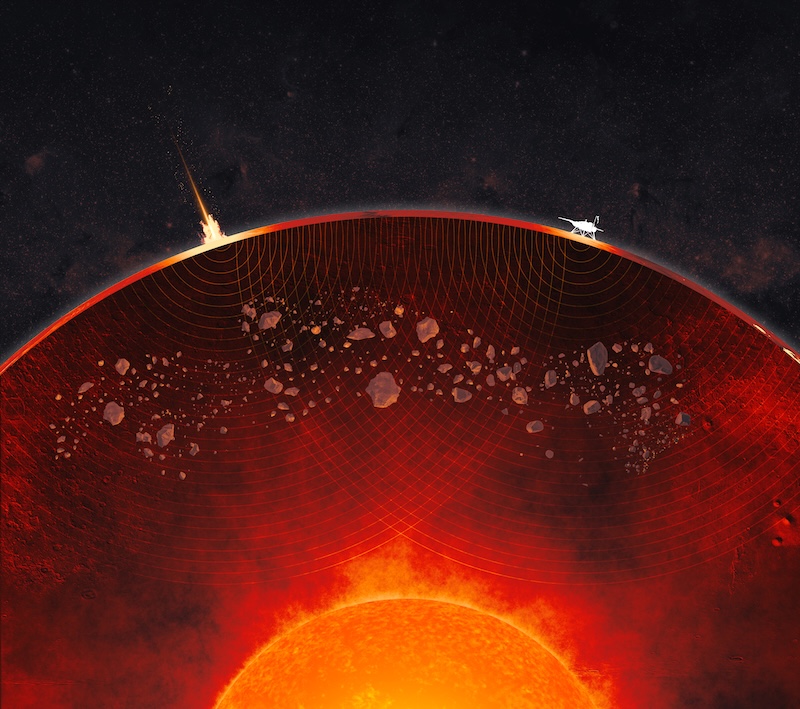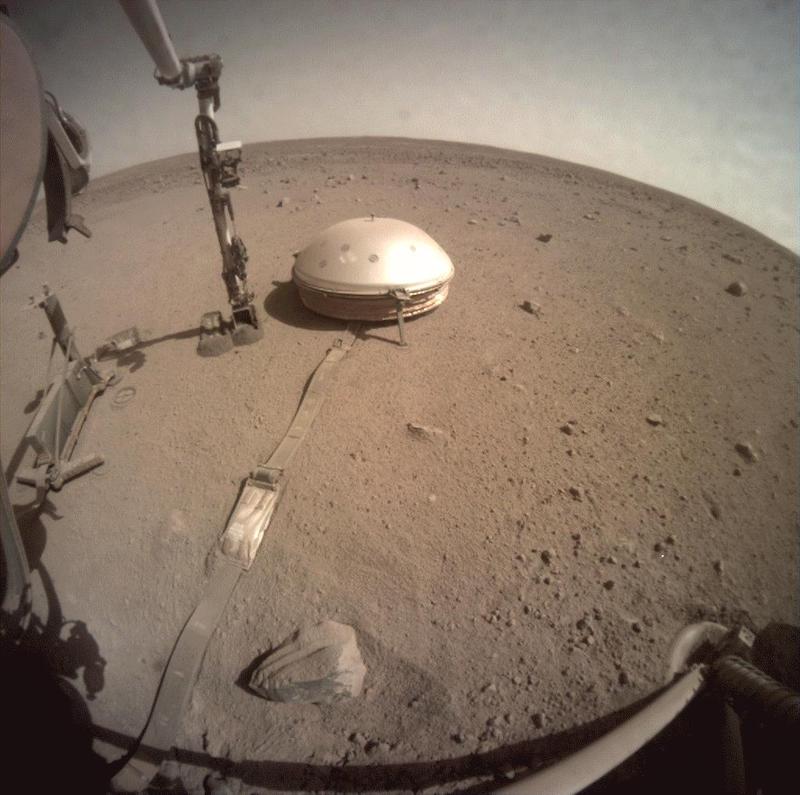
- The interior of Mars is lumpy, with chunks of debris deep in its mantle. But why?
- The rocky debris came from large impacts about 4.5 billion years ago, new research shows.
- Scientists used seismic marsquake data from the now-finished InSight mission to find the lumps.
Mars’ interior is lumpy, with rocky material left over from ancient impacts deep in its mantle. That’s the finding of a new study by researchers in the U.K., France and the U.S. The researchers said on August 28, 2025, that they found the evidence for this subsurface debris in data from NASA’s InSight lander mission, which ended in 2022. The data came from InSight’s analysis of marsquakes. The debris is scattered in giant lumps throughout the planet’s mantle.
The impacts also released an enormous amount of energy. In fact, they could have melted continent-sized portions of Mars’ crust and mantle. This would have formed oceans of magma within Mars. This in turn would have injected both the impact debris – and rocky material from Mars itself – deep into the mantle.
The researchers published the peer-reviewed results of their study in the journal Science on August 28, 2025.
NASA Marsquake Data Reveals Lumpy Nature of Red Planet’s Interiorastrobiology.com/2025/08/insi… #astrobiology #Mars
— Astrobiology (@astrobiology.bsky.social) 2025-08-30T17:37:56.460Z
A new look inside Mars
InSight studied the interior of Mars and monitored activity such as marsquakes, the Martian version of earthquakes.
The InSight data provides a unique and detailed glimpse inside Mars. Lead author Constantinos Charalambous at Imperial College London in the U.K. said:
We’ve never seen the inside of a planet in such fine detail and clarity before. What we’re seeing is a mantle studded with ancient fragments. Their survival to this day tells us Mars’ mantle has evolved sluggishly over billions of years. On Earth, features like these may well have been largely erased.
The researchers don’t know exactly what the rocky objects were that impacted Mars billions of years ago. They could have been asteroids or even larger protoplanets (smaller young “baby” planets).

Marsquakes reveal a lumpy mantle
InSight found the lumps by measuring marsquakes below the surface. Marsquakes are like earthquakes, except, of course, on Mars. The lumps are scattered throughout the mantle. The largest are about 2.5 miles (4 km) across. As Imperial College London describes it:
Mars’s interior is more like Rocky Road than Millionaire’s Shortbread.
As on Earth, marsquakes produce seismic waves that move through the planet’s interior. Mars doesn’t have tectonic plates to produce quakes. But rocks cracking under heat and pressure and meteoroid impacts can cause quakes on Mars. The ones that meteoroid impacts cause are stronger. They can send seismic waves deep into the mantle.
The new study focuses on eight marsquakes in particular. The seismic waves were strong, but the researchers noticed something interesting. The waves became altered deep in the mantle. What was causing that? As co-author Tom Pike at Imperial College London noted:
When we first saw this in our quake data, we thought the slowdowns were happening in the Martian crust. But then we noticed that the farther seismic waves travel through the mantle, the more these high-frequency signals were being delayed.

Scrambled seismic waves
The seismic waves slowed down and became scrambled in the mantle, but only in certain regions. Analysis of the InSight data showed that these were lumps in the mantle. The lumps also had a different composition than the surrounding rock. As Charalambous explained:
These signals showed clear signs of interference as they traveled through Mars’s deep interior. That’s consistent with a mantle full of structures of different compositional origins, leftovers from Mars’s early days.
The buried debris was later preserved below Mars’ crust. Charalambous said:
What happened on Mars is that, after those early events, the surface solidified into a stagnant lid. It sealed off the mantle beneath, locking in those ancient chaotic features, like a planetary time capsule.
The researchers determined that the lumps were rocky debris that came from impacts of asteroids or other rocky bodies about 4.5 billion years ago.

Oceans of magma
The impacts generated so much energy that they created oceans of magma beneath the surface. That magma carried the debris down into the planet’s mantle where it remains today. The debris was in various sizes, kind of like shards of broken glass. InSight detected some large pieces, but also many smaller ones.
Charalambous said:
These colossal impacts unleashed enough energy to melt large parts of the young planet into vast magma oceans. As those magma oceans cooled and crystallised, they left behind compositionally distinct lumps of material, and we believe it’s these we’re now detecting deep inside Mars.
Most of this chaos likely unfolded in Mars’s first 100 million years. The fact that we can still detect its traces after 4 1/2 billion years shows just how sluggishly Mars’s interior has been churning ever since.
On Earth, the interior is more active, and the debris would have been smoothed out into the surrounding mantle. But not so on Mars. Charalambous said that this:
… tells us Mars hasn’t undergone the vigorous churning that would have smoothed out these lumps.
Bottom line: A new study of seismic data from marsquakes shows that Mars’ interior is lumpy. The debris, deep in the mantle, comes from large impacts billions of years ago.
Source: Seismic evidence for a highly heterogeneous martian mantle











